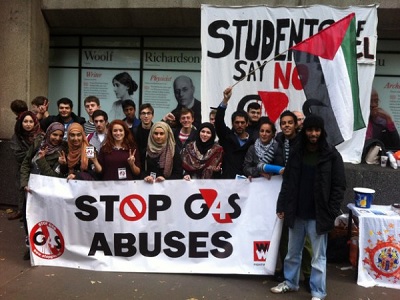
By Sabrien Amrov
The G4S security company has announced plans to leave the Israeli market. This is a big deal.
In 2002, the Israel Defence Forces (IDF) incorporated the activities of the largest multinational private security company to date, G4S1, in the management of the Israeli occupation of the West Bank and Gaza. Since then, G4S has held 90 per cent of the shares in its Israeli subsidiary. The company is the second largest actor in the management of the occupation after the IDF and the biggest private security employer both in Israel and around the world (G4S website).
In 2006, G4S took charge officially of the management of Israeli checkpoints2. The services it provides include providing scanners in the “buffer zone” and at the Erez checkpoint on the northern edge of the Gaza Strip. The zone is located within the occupied territories between the Green Line – the 1949 armistice line between Israel as it was established in 1948 and the West Bank – and the so-called Separation Wall (Nieuwhof 2012). G4S also provides security services at the checkpoints at the entrances to Qalandia, Bethlehem and Irtah, all connected to the Israeli wall built since 20013.
The system of checkpoints connected to the wall is designed to limit and control the movement of Palestinians within the West Bank. G4Sʼs presence was an attempt by Israel to normalise the occupation. By doing so, it sought to create a sense of permanency to the occupation which disconnects its reality from Israeli society while entrenching it within Palestinian society. The fact that this normalisation has been challenged and brought to an end is a victory to be celebrated.
The use of the term “border checkpoints” is a fairly recent phenomenon in the history of the occupation and management of the Palestinian population. In 1970 and 1980, the entry of Palestinians into Israel was barely even controlled. This was a policy introduced in order to create Palestinians’ economic dependency on the Israeli market (Gordon 2008, p21). It was only in the early 1990s that the situation began to change.
In January 1991, the general permission given for Palestinians to enter Israel openly was removed, and the application of the ban became effective from March 1993, with the declaration of a state of unlimited siege (Ibid). This implied that any Palestinian wishing to enter Israel had to present a circulation permit that had to be issued by the IDF and could only be granted under special circumstances (Hevkin 2008, p5). This restriction was formalised by the establishment of checkpoints along the roads linking the occupied Palestinian territories (OPTs) to Israel. Peace negotiations and the various agreements signed in the 1990s between Israel and the Palestinian leadership could not lead to a relaxation of this constraint; in fact, it became anything but relaxed.
In 1994, a “security fence” was built around the Gaza Strip; it was completed in January 1995. Under the pretence of security, the Israeli government decided to establish some degree of “separation” between the Israeli and Palestinian people (Gordon 2008, p32). To do so, dozens of crossing points were built in the buffer zone to control and monitor the movement of vehicles, goods and pedestrians between the West Bank or the Gaza Strip and Israel (Hevkin 2008, p6). However, due to the lack of physical separation, their effectiveness was limited.
It was only after the outbreak of the Second Intifada in 2000 that the Israeli government decided to build a physical barrier. The construction of the wall — the so-called “separation barrier” — was agreed by the Israeli government in 2002 and work began in 2003. The wall is the largest construction project envisaged by the State of Israel.
By the end of 2009, more than four hundred kilometres of the wall had been built. The “border checkpoints” became an integral part of this system of unilateral separation. However, insofar as these are the only legal border crossings of people and goods to and from the OPTs, these interfaces are an important meeting place for Palestinian and Israeli economic exchanges; simultaneously, they are a point of great tension between Palestinian civilians and Israeli soldiers.
In 2006, G4S took on the management of the main “border checkpoints” along the “separation barrier”. The company repackaged the checkpoints as “terminals” so as to give an impression of a normal, more modernized space (Mansbach 2009, p257). G4S supplies luggage scanning equipment and full body scanners in these “terminals”, as well as personnel. It manages the border crossing of Palestinian civilians on a daily basis. The integration of private companies in checkpoint management was precisely to create a more human face to what is essentially a military security device (Ibid, p256). According to an Israeli Ministry of Defense spokesperson on 26 December, 2006, “The process of transferring the operation of the border crossings into civilian hands is a humanitarian step that is meant to reduce the contact between the Palestinian population and the soldiers and, thus, to enable upgrading the checkpoints into formal crossing points.”
– Read more: Why the Divestment of G4S from Israel is a Big Deal – Sabrien Amrov, MEMO




